The NVIDIA GeForce GTX 1660 Super Review, Feat. EVGA SC Ultra: Recalibrating The Mainstream Market
by Ryan Smith on October 29, 2019 9:00 AM ESTPower, Temperatures, & Noise
Last, but not least of course, is our look at power, temperatures, and noise levels. While a high performing card is good in its own right, an excellent card can deliver great performance while also keeping power consumption and the resulting noise levels in check.
| NVIDIA GeForce Video Card Voltages | ||
| Model | Boost | Idle |
| EVGA GTX 1660 Super Ultra SC | 1.05v | 0.618v |
| GeForce GTX 1660 | 1.043v | 0.656v |
| GeForce GTX 1660 Ti | 1.005v | 0.65v |
Using the same TU116 GPU as the GTX 1660 Ti and the GTX 1660 (vanilla0, the voltages are unsurprisingly similar. 1.05v is essentially a universal limit for NVIDIA Turing GPUs at stock, while the idle voltage of 0.618v is a bit lower than what we’ve seen on other TU116 cards thus far.
| GeForce Video Card Average Clockspeeds | |||||
| Game | GTX 1660 Super (Ref Clocks) |
EVGA GTX 1660 Super SC Ultra |
GTX 1660 Ti | GTX 1660 | |
| Max Boost Clock | 1935MHz | 1980MHz | 1950MHz | 1935MHz | |
| Boost Clock | 1785MHz | 1830MHz | 1680MHz | 1785MHz | |
| Shadow of the Tomb Raider | 1860MHz | 1905MHz | 1875MHz | 1875MHz | |
| F1 2019 | 1860MHz | 1905MHz | 1890MHz | 1875MHz | |
| Assassion's Creed: Odyssey | 1875MHz | 1920MHz | 1905MHz | 1890MHz | |
| Metro: Exodus | 1860MHz | 1905MHz | 1890MHz | 1875MHz | |
| Strange Brigade | 1860MHz | 1905MHz | 1890MHz | 1890MHz | |
| Total War: Three Kingdoms | 1860MHz | 1890MHz | 1890MHz | 1875MHz | |
| The Division 2 | 1845MHz | 1875MHz | 1875MHz | 1860MHz | |
| Grand Theft Auto V | 1875MHz | 1920MHz | 1905MHz | 1890MHz | |
| Forza Horizon 4 | 1875MHz | 1905MHz | 1905MHz | 1890MHz | |
The situation with clockspeeds is also very similar, though not entirely a carbon copy of the GTX 1660 (vanilla). Even with NVIDIA’s slightly higher TDP, our GTX 1660 Super card sees a very slight drop in clockspeeds, typically coming in one bin (15MHz, or under-1%) below the original card. In this case it’s a tradeoff we’re glad to take, since as we’ve just seen, the extra memory bandwidth on the GTX 1660 Super more than makes up for any clockspeed deficit, launching the Super card well ahead of its GDDR5-based predecessor.
In any case, the GTX 1660 Super once again comes in well ahead of NVIDIA’s official boost clock specifications. Even under The Division 2, average clockspeeds beat the spec by 60MHz, and in other games It’s more frequently 75 to 90MHz above.
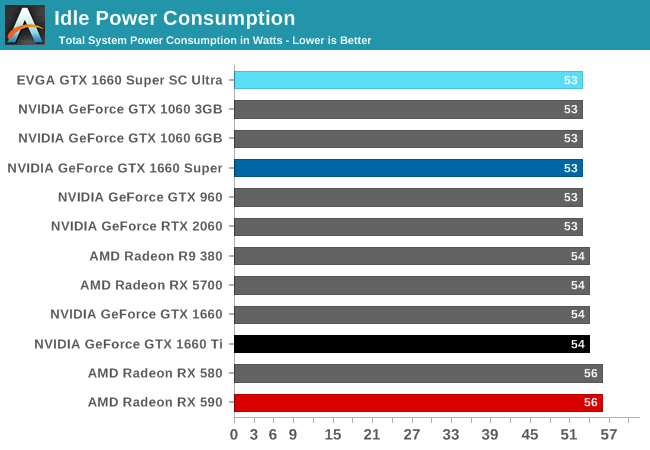
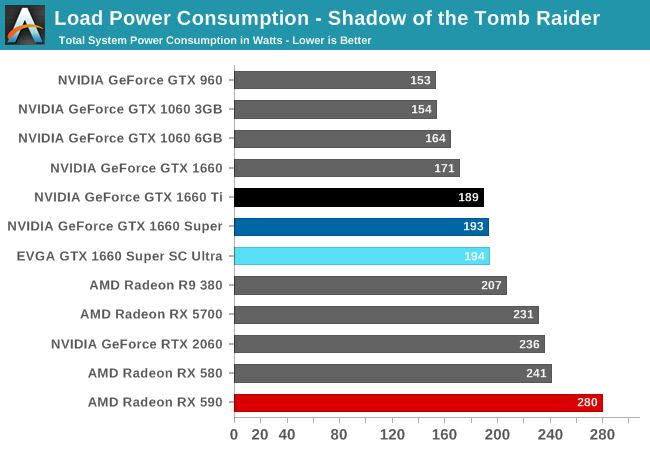
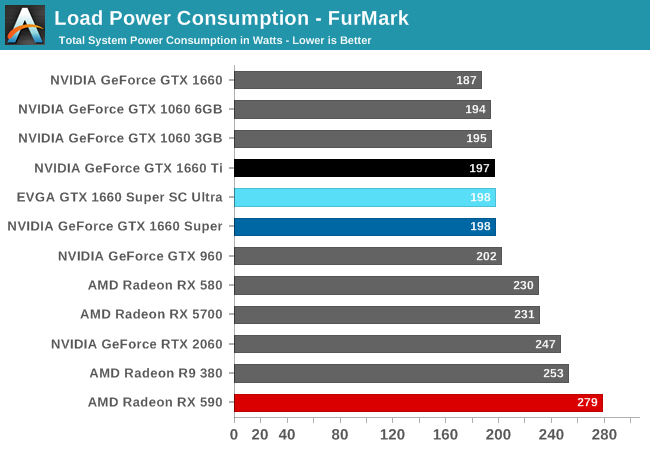
Shifting to power consumption, our results are in line with NVIDIA’s specifications, as well as what we’d expect for yet another TU116 card. With its 125W TGP, the GTX 1660 Super draws ever so slightly more power than either the GTX 1660 Ti or the GTX 1660, particularly in Tomb Raider where the CPU gets a bit more of a workout as well. But on the whole, it’s right in the ballpark with other 120W(ish) NVIDIA cards, with power consumption at the wall for the entire testbed not exceeding 200W.
For the midrange segment, the GTX 1660 Super (and the GTX 1660 Ti) are the cards to beat when it comes to power consumption and efficiency. Everything else at this power level performs much slower, or it’s faster while requiring more power. Though faster cards aren’t too far off, as the RX 5700 can attest to.
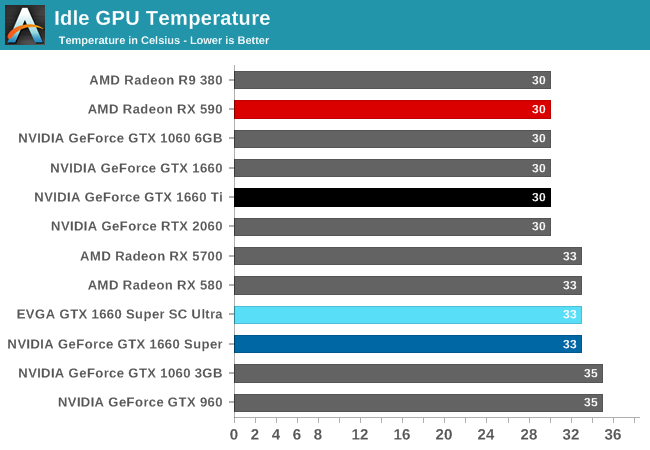


As for temperatures, EVGA has delivered one cool running card. Even at its full, factory overclocked speeds, the EVGA GTX 1660 Super SC Ultra never cracks 70C, and under FurMark’s pathological workload it’s the second-quietest card in these cards.
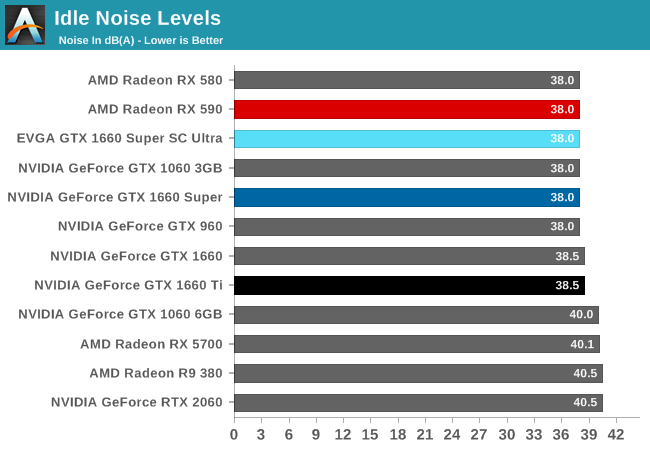

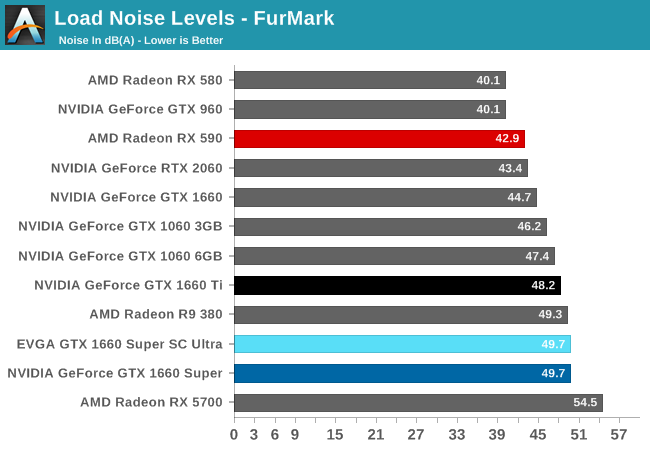
The tradeoff for those temperatures, however, is noise. The EVGA card that delivers chart-topping temperatures also delivers some of the worst noise results among this collection of cards.
The culprit here would seem to be EVGA’s decision to bias the card towards cooling performance rather than acoustics. Which given how far the card is from its 83C thermal throttle point, seems overdone. EVGA could easily back off on the fan speed a bit, let the temperatures drift up to the low 70s, and deliver essentially the same gaming performance (perhaps losing 1 bin in the process) while generating a lot less noise. We have a number of 120W open air cards in these cards, including the GTX 1660 3GB and GTX 960, both of which move just as much heat with much less noise, so it can be done. And, to be fair to EVGA here, their SC Ultra card is by no means a tornado, barely hitting 50 dB(A) in these intensive, open case tests, but the best cards strike a proper balance between noise and performance, maximizing the latter while minimizing the former.
Ultimately, I suspect part of the engineering challenge EVGA is dealing with here is that the SC Ultra cooler is their smallest GTX 1660 cooler. The triple-slot XC cards (represented here with the GTX 1660 Ti and GTX 1660) have just one fan and much bigger heatsinks to work with. Similarly, EVGA also sells longer dual-slot cards (also called XC) which get the benefit of a longer heatsink. The physics of more heatsink mass (and more/bigger fins) can’t be ignored, which is why smaller cards often need to run faster fans. Still, even if the SC Ultra cooler isn’t particularly big, I do think there’s room for a better fan balance here.
Tangentially, as I mentioned in the EVGA SC Ultra overview, this is actually our second card. The original was even hotter and louder; it reached 75C and 54.6 dB(A) under Tomb Raider in that test. Considering that these GTX 1660 Super cards are operating near or at their power limits and are TDP-capped by the VRMs and monitoring hardware – and thus, one card can’t draw significantly more power than another identical card – it points to a cooling problem with the card itself. EVGA has since taken the card back to figure out what’s going on, but I suspect what they’ll find is poor thermal transfer between the GPU and heatsink, perhaps due to a bad TIM application or a problem with the heatpipes. Ultimately it’s rare that we get dud video cards, but it does happen now and then.


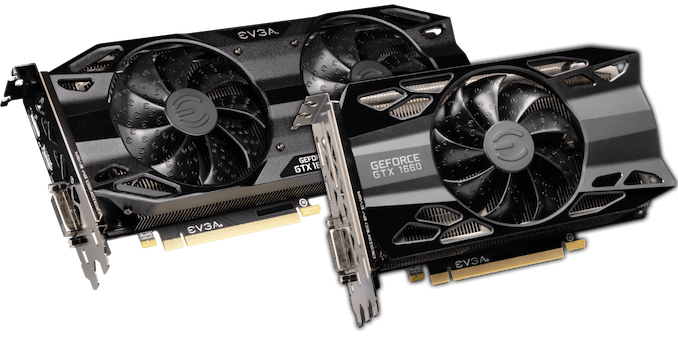








65 Comments
View All Comments
dromoxen - Friday, November 8, 2019 - link
MAkes you wonder what NV will do for a GTX1660ti Soupa, maybe faster gddr6 and have 8gb of it? or a half assed RT cores added *clsmithj - Tuesday, October 29, 2019 - link
I'd argue the 1660Ti is still the better choice, it's a full TU116 with the most CUDAs and it's GDDR6 memory has only factory underclocked to run at 12000MHz for 288GB/s, you can easily overclock it to 13000MHz and remove the underclock and get the 336GB/s speed. With my Aorus version, I can easily push it to 13336Mhz for 352GB/s bandwidth.The GTX 1660 Ti is essentially equal to the GTX 1070 Ti.
The_Assimilator - Wednesday, October 30, 2019 - link
"The GTX 1660 Ti is essentially equal to the GTX 1070 Ti."HAHAHA keep smoking the good stuff.
Spunjji - Wednesday, October 30, 2019 - link
Not sure why the snark - he's correct, an overclocked 1660Ti is roughly equivalent to a stock 1070Ti:https://www.guru3d.com/articles_pages/msi_geforce_...
Of course the 1070Ti owner can probably squeeze a little more out of that card too, but that's not really the point.
Flunk - Friday, November 1, 2019 - link
Comparing stock to overclocked doesn't make sense, if they're both overclocked the 1070 ti takes it.TheSkullCaveIsADarkPlace - Saturday, November 2, 2019 - link
Hogwash! The GTX 1660 Ti is clearly a bit faster than a GTX 1070 Ti. I don't have a reference or numbers at hand, but i am confident that an underclocked 1070 Ti will have somwhat lower performance compared to an overclocked 1660 Ti.Sure, the 1660 Ti owner could also underclock its card (if possible in a similar manner as with 10-series cards). But hey, that's not really the point.
flyingpants265 - Wednesday, October 30, 2019 - link
It's another waste-of-time card. What we really needed is an AMD 5600XT for $199. Or something like that. Performing like a 2060, for much less.Ourchasing a 1080p card now is kind of ridiculous, also.
JoeyJoJo123 - Wednesday, October 30, 2019 - link
Why would purchasing a "1080p card" be ridiculous? What qualifies as a 1080p card? Because it's cheap? Because it's "last gen"?https://www.youtube.com/watch?v=HyonSgZiwsE
You know any 3 year old GPU can do 4K gaming after some settings tweaks, all that really matters is that it's a relatively recent (within 2 or 3 gens old) and that it's got a ~4GB framebuffer. I'm not really here to diss anyone's budget. If someone's got to make a $500 PC tower budget work, then a $100 used GPU or a "1080p card" seems pretty sensible.
Xyler94 - Thursday, October 31, 2019 - link
A "1080p" card usually refers to any graphics card that can easily handle 1080p, but struggles with 1440p. Now this assumes high detail of course. You can play 1440p low, or 1080p high, it's your choice really, but I'd rather not have to resort to low settings just to bump my resolution. because what's the point? You gain pixels, but lose detail, which is what pixel gains are supposed to show off...Oliseo - Friday, November 1, 2019 - link
Or you could play 1440 on medium-highIt's nonsense to claim you have to go straight to low going from 1080 to 1440.
As the data in the graphs in the article CLEARLY show.
Try reading the article.